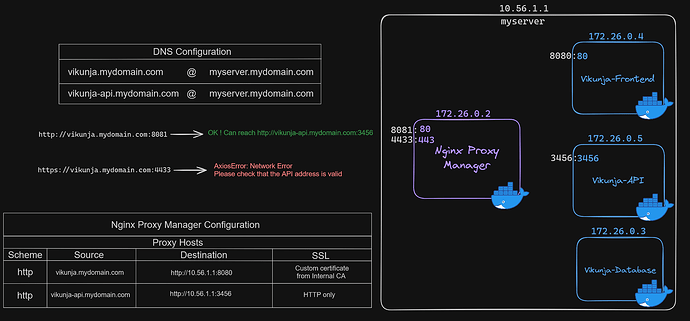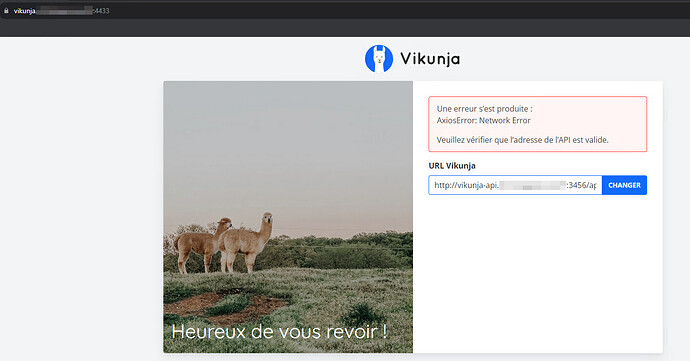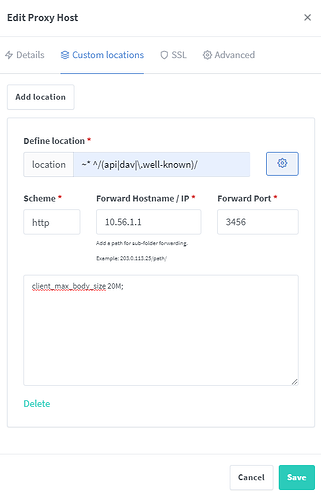Hello everyone,
I’ve been trying to install Vikunja by setting HTTPS between the clients and my Reverse Proxy for several days now, but I’m getting the following error: “AxiosError: Network Error Please check that the API address is valid.”
I’ve looked at all the possible configurations, I’ve already consulted many posts on this community forum and on others too but I can’t find any solution to my issue, although in some posts some of you have managed to set up an SSL/TLS link.
To be clear, here is an illustration of my installation :
Firstly, this is a test installation, which is why everything is on the same machine. In a real case, I’d like to use a Reverse Proxy on another machine. That’s why I’ve redirected my Nginx Proxy Manager to the main “myserver” host and not directly to the IPs of my containers.
So I want to use Nginx Proxy Manager and deploy the Vikunja stack without the Nginx Vikunja-Proxy.
You’ll notice that I’ve also created aliases for the Vikunja web application and its API in my DNS server.
In this configuration, I’d like the connection between my clients and the Reverse Proxy to be encrypted, and this is not a problem if the rest of the communication between the API and the Frontend is done over HTTP.
(If it’s possible to have a completely encrypted configuration, I’d like to set that up too, but I want to solve my first problem first.)
In my current configuration, everything works perfectly well in HTTP. However, when I set up my internal certificates on the Proxy Host “vikunja.mydomain.com”, Vikunja switches to HTTPS, but it becomes impossible to reach the API. The error that appears is as follows: AxiosError: Network Error Please check that the API address is valid
I don’t understand what the problem is, because as far as I’m concerned, the rest of the communication takes place over HTTP and Nginx Proxy Manager handles the encryption.
To illustrate the error code, here are 2 screenshots of the full HTTP mode and one when I enable SSL on my Proxy Host :
(See next posts please because I have new account restrictions)
To complete that, you will find my docker-compose.yml configuration in the following code :
version: '3'
services:
db:
image: mariadb:10
command: --character-set-server=utf8mb4 --collation-server=utf8mb4_unicode_ci
environment:
MYSQL_ROOT_PASSWORD: supersecret
MYSQL_USER: vikunja
MYSQL_PASSWORD: secret
MYSQL_DATABASE: vikunja
volumes:
- ./db:/var/lib/mysql
restart: unless-stopped
networks:
- nginx_proxy_manager_default
api:
image: vikunja/api
environment:
VIKUNJA_DATABASE_HOST: db
VIKUNJA_DATABASE_PASSWORD: secret
VIKUNJA_DATABASE_TYPE: mysql
VIKUNJA_DATABASE_USER: vikunja
VIKUNJA_DATABASE_DATABASE: vikunja
VIKUNJA_SERVICE_JWTSECRET: jwtsecret
VIKUNJA_SERVICE_FRONTENDURL: http://vikunja.mydomain.com:8081/
VIKUNJA_LOG_LEVEL: DEBUG
ports:
- 3456:3456
volumes:
- ./files:/app/vikunja/files
depends_on:
- db
restart: unless-stopped
networks:
- nginx_proxy_manager_default
frontend:
image: vikunja/frontend
ports:
- 8080:80
environment:
VIKUNJA_API_URL: http://vikunja-api.mydomain.com:3456/api/v1/
VIKUNJA_LOG_LEVEL: DEBUG
restart: unless-stopped
networks:
- nginx_proxy_manager_default
networks:
nginx_proxy_manager_default:
external: true
I configured the “VIKUNJA_LOG_LEVEL” but I don’t have any more relevant logs.
Also, I tried the following configuration with the Vikunja-Proxy but I couldn’t get it work …
Moreover I’ve also tested the following step-by-step documentations, which correspond exactly to what I want to do, but each time I get the same error once SSL has been activated.
(See links on next post please beacause I have new account restrictions)
Finally I ask myself a few questions in all this:
- Is the Vikunja-Proxy essential in my configuration?
In principle, no, because the documentation offers to do without and I can’t see any other use for it apart from making things harder for myself with a double reverse proxy.
- I’ve also read that in this case, both the Backend and Frontend would have to be in HTTPS, but I can’t see how to configure this at the container level.
So if you have any answers, I would be very grateful because I have already spent a lot of time debugging something that is generally quite simple in the first place.
Thank you for reading and for your help.
Have a nice day !





